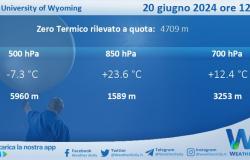Anecdotes, events and curiosities of the more contemporary history of the Fiumicino area
by Roberto Saoncella
He was not a politician, but first of all he understood the development potential that the Isola Sacra area would experience between the 1950s and 1960s. He wasn’t a doctor, but he knew the names of all the area residents by heart. He was not a relative of each of us, but at least once a year he knocked on every door to talk, have a coffee or give a blessing.
We are talking about a historical figure for Fiumicino, namely Father Alberico Papi, founder and parish priest (uninterrupted almost until his death), of Stella Maris parish. Having entered the seminary at a very young age, he was ordained a priest in the congregation of the sons of Santa Maria Immacolata on 6 April 1947. Having arrived in Fiumicino he became deputy parish priest of the central Santa Maria Porto della Salute. In 1955, on behalf of the parish priest Barbieri, he began his mission in what he called the “lido del Faro village”.
He celebrated mass, heard confessions and tutored Latin and French in an improvised chapel on the seafront in front of the then Miramare establishment. Few residents, no more than 50 people lived in the area, all without water or sewers. The following year, in 1956, after much insistence, he convinces Cardinal Eugenio Tisserant, bishop of Fiumicino, to buy land in the middle of nowhere, along a dirt road that still had no name and which would later become via Giorgio Giorgis.
Father Papi is convinced that that area will have rapid development, and the church that will arise will have to be large, modern and welcoming. In 1959 the first chapel of the new church (i.e. the current building next to the bus stop on Via Giorgio Giorgis) was ready. The following year the bishop issued the decree that transformed the church of Stella Maris into a parish, and Father Alberico Papi was appointed parish priest. Two years later in 1962, the deputy parish priest Father Franco Bortoloni also arrived.
For decades Father Franco and Father Papi remained an inseparable pair, like Sandra and Raimondo, Franco and Ciccio or Cochi and Renato. For those like me who were born in Fiumicino and grew up in the eighties, we didn’t go to church at Stella Maris, but rather to Father Papi. In 1976 his construction work on the church ended with the construction of the new building. By placing the relics of Padre Pio, Saint Paola Frassinetti and Don Bosco in the main altar, Bishop Monsignor Andrea Pancrazio consecrated what is still the largest church in Fiumicino today.
In the meantime, in fact, Father Papi’s prophecy had come true and the then Lido del Faro village of a few dozen inhabitants had become an extension of Fiumicino across the river, with almost 20,000 residents. Throughout the nineties Alberico, as no one called him, continued his pastoral work with his usual method: on his bicycle, house to house, always ready to find the right phrase for every person he met. He loved showing off his memory and his linguistic skills. He would meet you and tell you the street and number where you lived and if he could, he would also describe your family and the house where you lived. As he spoke he interspersed small phrases in French or Spanish, greetings in German or long Latin quotations. He passed away in 2015. His brothers say that his last word was “here I am”.
A priest and a man from other times, to whom I think Fiumicino owes a lot. And this is how we like to remember him, on the occasion of the week of celebrations of “his” Stella Maris parish, which are about to begin. A celebration that year after year recalls that 21 June 1959 when, under the sun and surrounded by a small crowd of people, Father Papi brought for the first time, into the new chapel, the statue of the Madonna still visible today on the side altar of the Church.





